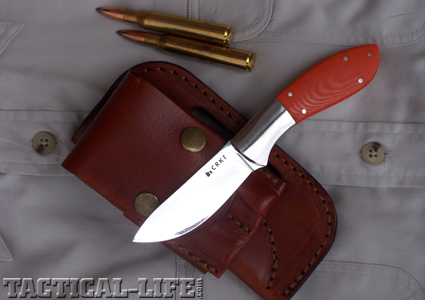It never ceases to amaze me how some blade steels receive all the attention, while others quietly remain in the shadows. For example, mention any of the domestic 400 series or Japanese AUS steels and everyone from knife makers to users will have an opinion. Even the premium steels, like ATS-34, BG-42, VG-10, CPM S30V and CPM S90V have their own turn at the spotlight. However, mention Sandvik 12C27 and you’re apt to get a blank stare. Even those who chime in on the various Internet knife forums seem to manifest more curiosity than knowledge about the steel’s performance parameters.
During a recent conversation with knife maker Russ Kommer, he mentioned the folks at the Swedish Sandvik steel firm had sent him some samples of their 12C27 stainless and he was anxious to tell me all about his experience with this steel. When Russ Kommer gets excited about something, you end up on the other end of a one-way conversation.
Secrets Of Sandvik
“Sandvik 12C27 is really clean steel. It’s not like some other stainless products that have a lot of junk in them. It can be heat-treated to Rc 59 for superior edge holding. And it takes an awesome (Russ uses this word a lot) mirror polish. I made a test knife out of the steel and used it to field-dress and skin a whole bunch of whitetail deer. Amazingly, I only had to touch up the edge once. The steel out-cuts 420J by a mile, as well as most offshore-produced stainless,” Russ said.
Advertisement — Continue Reading Below
Obviously, Russ Kommer likes Sandvik 12C27. Other folks are also fans of this Swedish steel. One glance through the catalogs of Browning, Columbia River Knife & Tool, Gerber, Ka-bar and several other production cutlery firms and you’ll see the steel used in a number of knives. The reason behind all of this lies in the combination of good corrosion resistance and superior edge retention.
A look at the chemical composition of Sandvik 12C27 sheds some light on its superior performance. The specifications are: Carbon .60%, Chromium 13.5%, Manganese .40%, Phosphorous .025%, Silicon .40% and Sulfur .010%.
True Edge Holder
With a higher Carbon content than several widely used alloys (AUS4, 420J, 1.4116 and 3Cr13) and a greater hardness value, it’s obvious why Sandvik 12C27 possesses enhanced edge retention. Moreover, the performance of the steel compares very favorably to AUS 8 and ATS-34, both well-known premium alloys.
Advertisement — Continue Reading Below
Steel formulation is one thing, actual field performance is where the “rubber meets the road.” Since experiencing this Swedish steel firsthand is the only way to evaluate its strengths, I asked the folks at CRKT (Columbia River Knife & Tool) to send me one of their new 2-Shot (Model 2840) hunting knives. Designed by Russ Kommer (who else?), this handy little fixed-blade features a full-tang blade crafted from Sandvik 12C27 and Rockwell hardened to Rc 59-61.
It just so happened that some friends had invited me along on an axis deer hunt in Hawaii. Obviously, deer hunting in the islands would provide the first-hand experience needed to gain a better understanding of the blade steel. It didn’t take more than a couple of days of hunting to score on two nice bucks. Then it was my turn to jump into the fray. I rolled up my sleeves and put the Sandvik 12C27 blade to the test.
Axis deer are about the size of a mature mule deer. The warm weather in the Islands meant that field care had to be undertaken quickly to forestall spoilage. Field dressing both animals was no trick at all. The blade slid through the hide without hesitation and the edge remained sharp throughout the entire procedure.
Advertisement — Continue Reading Below
Field Results
Since we wanted to cool the carcasses as much as possible, I also used the knife for hide removal. This is the point where most knives start to “go south.” Cutting through and across deer hair can dull a blade quickly, but I only had to touch up the blade edge once to keep it in top condition. After the work was done, the mirror-finished blade was a snap to clean. This field experience with Sandvik 12C27 established the fact that it makes a fine hunting knife blade. Furthermore, it isn’t nearly as costly as many of the premium blade steels, yet it offers comparable performance. What more could you ask for? For more information go to www.crkt.com.























